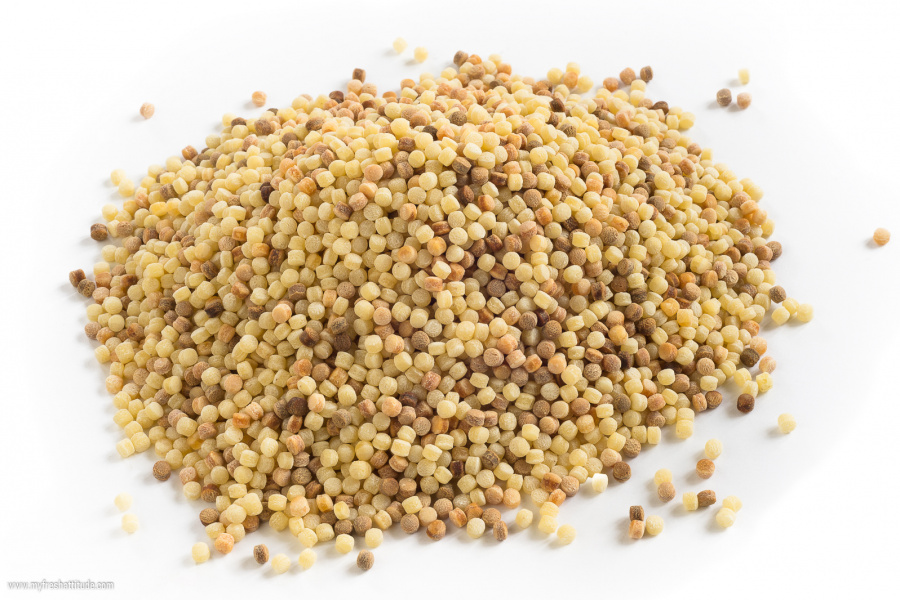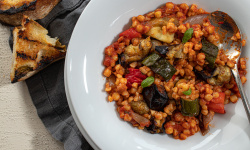
Fregola
Fregola falls somewhere between pasta and couscous.
Pasta is generally made by combining semolina (durum wheat) flour and water. The resulting dough is kneaded to help construct a strong gluten network before being stretched into any shape. Traditional North African couscous is made in a large bowl (wooden or terra cotta). Coarsely ground semolina flour is mixed with finely ground semolina flour and warm water. The water is added slowly while the dough is constantly rolled between the hands to formulate small balls. Couscous is then sifted to create uniform small pieces before it is steamed. Fregola uses only coarsely ground semolina flour mixed with warm water and rolled in the same manner as couscous. The resulting balls are much larger and they are not sifted. Instead, freshly formed fregola is air dried completely, then toasted in a moderate oven for about 15 minutes. The results are non-uniform, moderately sized balls that have a golden or slightly darker color. The toasting process also creates a nutty flavor.
Most people call this Sardinian specialty “fregola,” but the proper Italian name is “fregula” – a term resembling the meaning for crumbs in older Italian terms.
Fregola dates back to the 10th century. The earliest recipes show up around the 14th century from a northern Sardinian village. The origin of fregola is unclear. It is perfectly reasonable (as most people believe) to imagine it as a close relative to couscous – especially when you consider the influence from nearby Sicily and their history with couscous. But patriotic Sardinians maintain it is an original Sardinian creation.
Purchasing Fregola
Fregola is not simple to find outside of Italy, especially if you are interested in maintaining the integrity of the product and purchasing something authentic. Online sources may be your best alternative, unless of course you are planning a trip to Sardinia.
Generally, there are two sizes to consider – small and large. The small size is roughly the size of a small grain. The larger variety is somewhat smaller than a pea. The color should be golden, with shades of darker colors throughout. The size is not terribly uniform, but it should be close.
Cooking Fregola
Cooking fregola is simple. Bring a large pot of water to a boil, then add enough salt so that the water tastes a bit like the sea. Add the fregola to the boiling water, then reduce the temperature to maintain a gentle boil. The fregola is done in about 10-14 minutes – starting tasting it around 10 minutes into the process. Don’t walk away from the stove if you are cooking fregola – it is notorious for boiling over if you leave the temperature too high.
I like to cook fregola first, then mix it in a large pan that has some kind of stew working – generally tomato-based with a hint of saffron. I add my pre-cooked vegetables depending on season, mix and adjust seasoning then enjoy right away.
You can cook your fregola directly in the stew or soup if you would prefer. Just make sure there is plenty of liquid to cook the fregola without it drying too much. Cooked in this manner generally requires a few extra minutes of cooking time.
Jack’s Fresh Tip

There are a number of substitutions to consider if you cannot find proper fregola, but you want to make a similar a recipe. Israeli couscous or Lebanese couscous (called moghrabieh) is similar to fregola, although both products are not toasted in the same way as fregola. Any sort of pearl shaped pasta is another consideration – these are simple products to find in supermarkets throughout the world. Alternatively, bulgur, orzo and even buckwheat are grains and seeds that will also work. Just be sure to cook them completely first, then replace the fregola in a recipe.
Recipes with Fregola

There are no comments